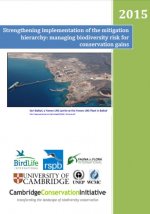Strengthening implementation of the mitigation hierarchy
managing biodiversity risk for conservation gains
By Cambridge Conservation Initiative View PublicationThe scale and pace of development is intensifying across the mining, oil & gas, agriculture, infrastructure, forestry and housing sectors. Such rapid and large scale expansion in commercial development threatens to irreversibly transform landscapes around the world, putting pressure on biodiversity and the people that depend on it for their livelihoods and well-being.
Understanding the ecological and social impacts of proposed development and planning appropriate measures to mitigate those impacts wherever possible is critical. The mitigation hierarchy is a process that when used properly can ensure that development results in No Net Loss (NNL) of, or a Net Positive Impact (NPI) on biodiversity. It involves four key stages beginning with the avoidance of impacts. Where avoidance is not possible, the developer must seek to minimize impacts and restore areas. The last stage, and final resort, is to consider the potential to offset residual impacts. Given the inherent risks and uncertainty involved with offsetting, it should only ever be undertaken as a last resort, when harm to biodiversity cannot be avoided or mitigated. If it is not possible to avoid, minimize or adequately offset harm, the development should not proceed.
The first and arguably most important stage in the mitigation hierarchy – avoidance – requires that measures [are] taken to anticipate and prevent adverse impacts on biodiversity before actions or decisions are taken that could lead to such impacts (CSBI, 2015). Effective impact avoidance is vital to achieving NNL or NPI goals and reducing business risk. Yet in practice, impact avoidance is often overlooked, misunderstood and poorly applied. There is also a paucity of information available to support the design and implementation of effective avoidance strategies.

